Design Multiloop Control System
In many applications, a single-loop control system is not feasible due to your plant design or design requirements. If you have a design with an inner and outer loop, you can use Control System Designer to design compensators for both loops.
The typical workflow is to tune the compensator for the inner loop first, by isolating the inner loop from the rest of the control system. Once the inner loop is satisfactorily tuned, tune the outer loop to achieve your desired closed-loop response.
System Model
For this example develop a position control system for a DC motor. A single-loop angular velocity controller is designed in Bode Diagram Design. To design an angular position controller, add an outer loop that contains an integrator.
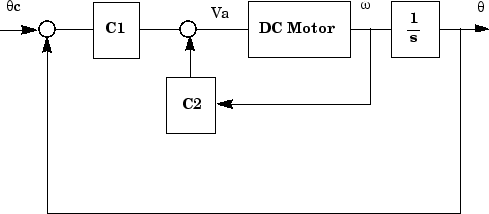
Define a state-space plant model, as described in SISO Example: The DC Motor.
% Define the motor parameters R = 2.0 L = 0.5 Km = .015 Kb = .015 Kf = 0.2 J = 0.02 % Create the state-space model A = [-R/L -Kb/L; Km/J -Kf/J] B = [1/L; 0]; C = [0 1]; D = [0]; sys_dc = ss(A,B,C,D);
Design Objectives
The design objective is to minimize the closed-loop step response settling time, while maintaining an inner-loop phase margin of at least 65 degrees with maximum bandwidth:
Minimal closed-loop step response settling time.
Inner-loop phase margin of at least 65 degrees.
Maximum inner-loop bandwidth.
Match System to Control Architecture
Control System Designer has six possible control architectures from which you can choose. For more information on these architectures, see Feedback Control Architectures in Control System Designer.
For this example use Configuration 4, which has an inner and outer control loop.
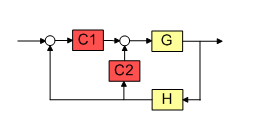
Currently, the control system structure does not match Configuration 4. However, using block diagram algebra, you can modify the system model by adding:
An integrator to the motor output to get the angular displacement.
A differentiator to the inner-loop feedback path.

At the MATLAB® command line, add the integrator to the motor plant model.
plant = sys_dc*tf(1,[1,0]);
Create an initial model of the inner-loop compensator that contains the feedback differentiator.
Cdiff = tf('s');Define Control Architecture
Open Control System Designer.
controlSystemDesigner
In Control System Designer, on the Control System tab, click Edit Architecture.
In the Edit Architecture dialog box, under Select Control Architecture, click the fourth architecture.
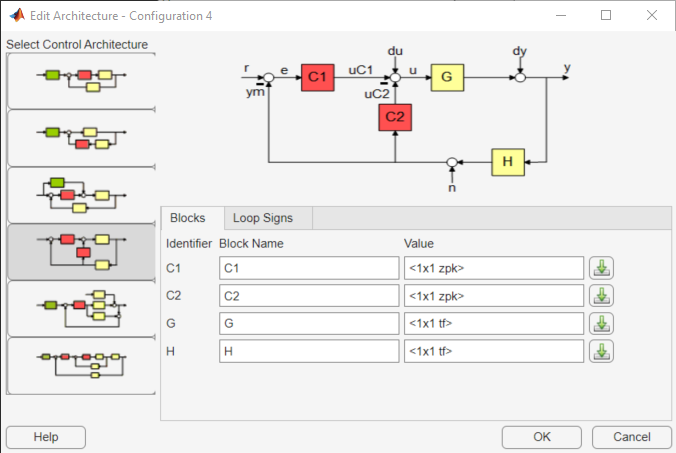
Import the plant and controller models from the MATLAB workspace.
In the Blocks tab, for:
Controller C2, specify a Value of
Cdiff.Plant G, specify a Value of
plant.
Click OK.
The app updates the control architecture and imports the specified models for the motor plant and the inner-loop controller.
In Control System Designer, the following plots open:
Bode Editor for LoopTransfer_C1 — Open-loop Bode Editor for the outer loop
Root Locus Editor for LoopTransfer_C1 — Open-loop Root Locus Editor for the outer loop
Bode Editor for LoopTransfer_C2 — Open-loop Bode Editor for the inner loop
Root Locus Editor for LoopTransfer_C2 — Open-loop root Locus Editor for the inner loop
IOTransfer_r2y: step — Overall closed-loop step response from input r to output y
For this example, close the Bode Editor for LoopTransfer_C1 and Root Locus Editor for LoopTransfer_C2 plots.
Since the inner loop is tuned first, configure the plots to view just the inner-loop Bode editor plot. To the side of the plot tab, click arrow and select Tile All, then click Single.

Isolate Inner Loop
To isolate the inner loop from the rest of the control system architecture,
add a loop opening to the open-loop response of the inner loop. In the data
browser, right-click LoopTransfer_C2, and select
Open Selection.
To add a loop opening at the output of outer-loop compensator,
C1, in the Open-Loop Transfer Function dialog box,
click ![]() Add loop opening location to list. Then, select
uC1.
Add loop opening location to list. Then, select
uC1.

Click OK.
The app adds a loop opening at the selected location. This opening removes the effect of the outer control loop on the open-loop transfer function of the inner loop.
The Bode Editor response plot updates to reflect the new open-loop transfer function.
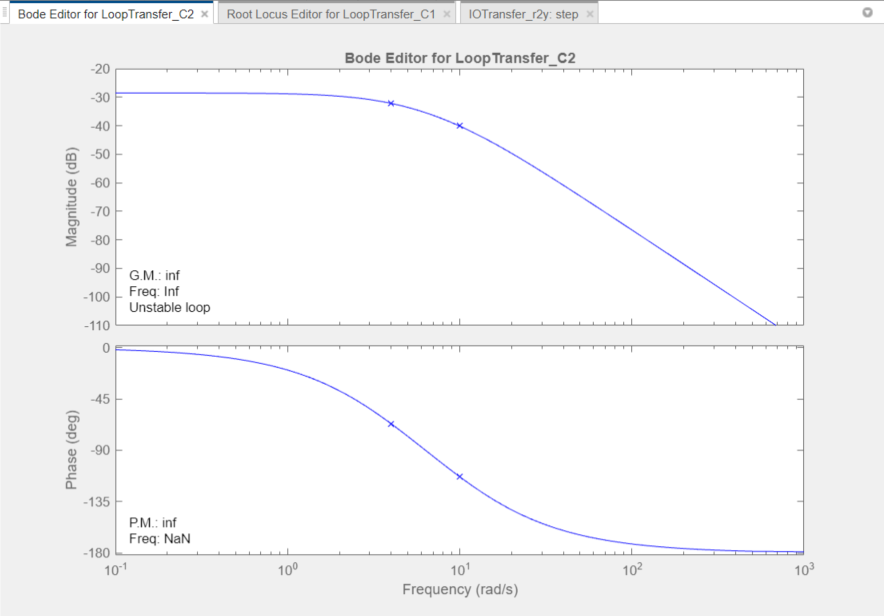
Tune Inner Loop
To increase the bandwidth of the inner loop, increase the gain of compensator C2.
In the Bode Editor plot, drag the magnitude response
upward until the phase margin is 65 degrees. This corresponds to a compensator
gain of 107. Increasing the gain further reduces the phase
margin below 65 degrees.
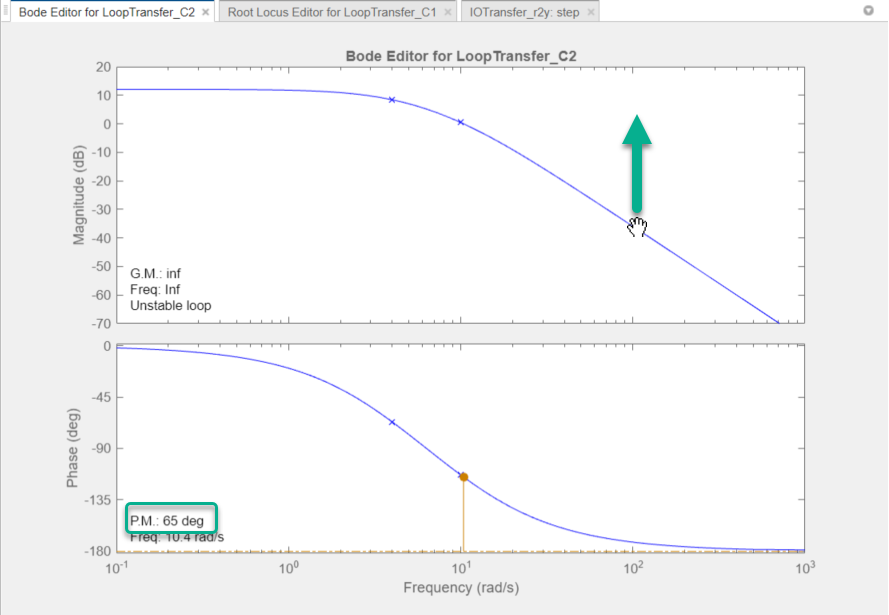
Alternatively, you can adjust the gain value using the compensator editor. For more information, see Edit Compensator Dynamics in Control System Designer.
Tune Outer Loop
With the inner loop tuned, you can now tune the outer loop to reduce the closed-loop settling time.
In Control System Designer, from Tile All tab, select Left/Right. Arrange the plots to display the Root Locus for LoopTransfer_C1 and IOTransfer_r2y_step plots simultaneously.
To view the current settling time, right-click in the step response plot and select Characteristics > Settling Time.
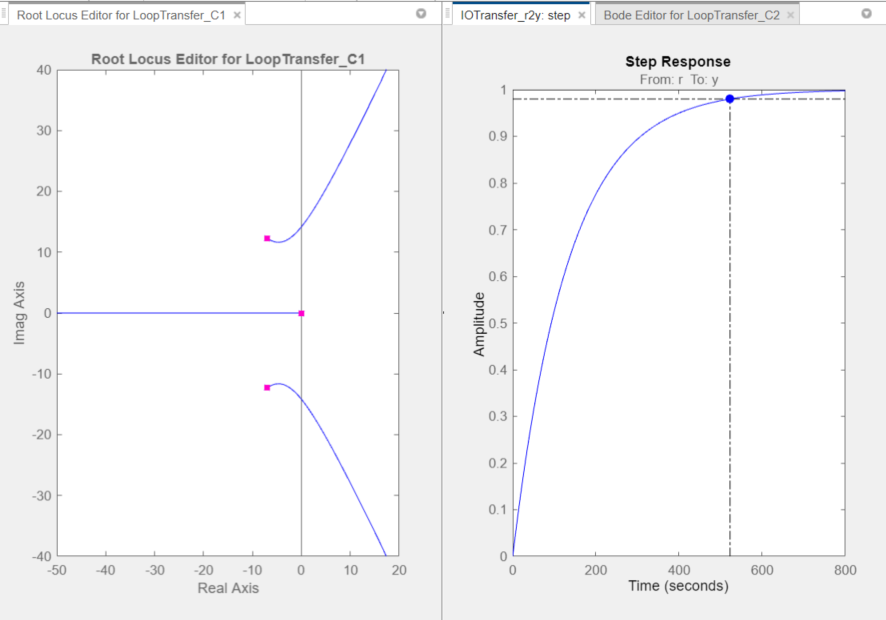
The current closed-loop settling time is greater than 500 seconds.
In the Root Locus Editor, increase the gain of
compensator C1. As the gain increases, the complex pole
pair moves toward a slower time constant and the real pole moves toward a faster
time constant. A gain of 600 produces a good compromise
between rise time and settling time.
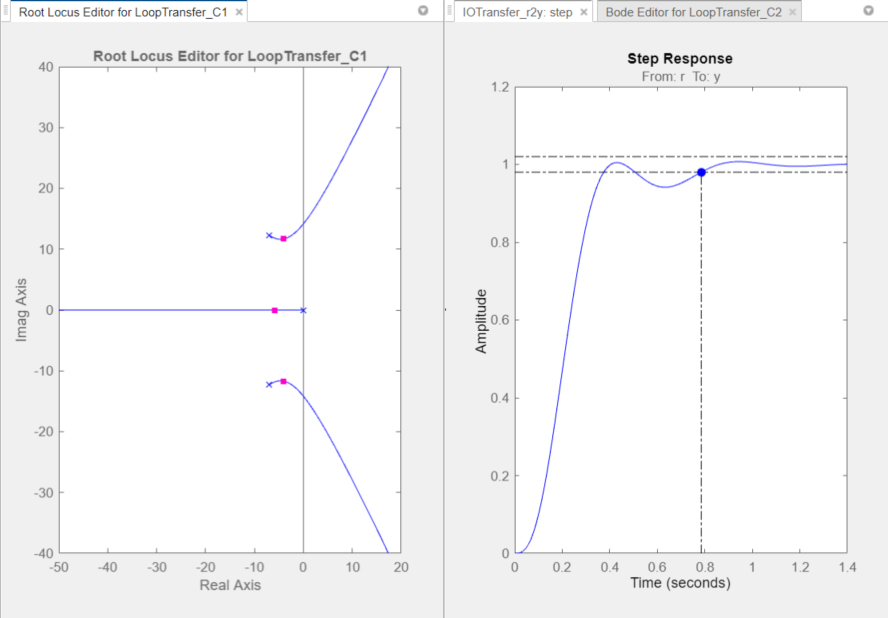
With a closed-loop settling time below 0.8 seconds and an inner-loop phase margin of 65 degrees, the design satisfies the design requirements.